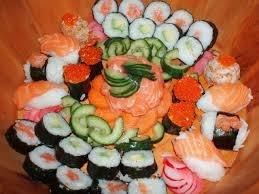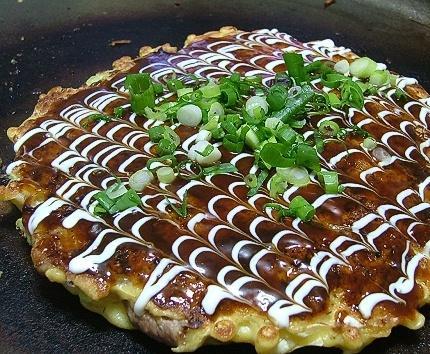Introduction
For centuries, Japanese have used food and their recipes to present some aspects of their cultures and traditions. Different Japanese dishes stand for various cultures and tradition that are dominant in Japan. Remarkably, individuals in Japan use their different recipes and food to express some aspects of their culture. Since Japanese food has been in existence for several years, they represent a significant part of their lifestyles. Therefore, the essay explains the cultural presentation of Sushi and Okonomiyaki recipes.
The study sought the information concerning sushi and Okonomiyaki, the two types of recipes, from middle-aged man, Jackie Akiyoshi, who is 43 years old. Akiyoshi is a chef, who works at a Japanese restaurant. Akiyoshi understands Japanese dishes and traditions because he was born and raised in the region of Kanto, which lies in the eastern part of Honshu and hails from Otomo clan. In addition, Akiyoshi loves football and is member of Otomo cultural association. As a result, he is one of the individuals, who has a wealth of information concerning Japanese dishes, cuisines, recipes, and their cultural representations. Therefore, by using Akiyoshi as the informant, the essay collected the relevant information about sushi and Okonomiyaki recipes and the roles they play in the Japanese culture.
Presently, Sushi and Okonomiyaki recipes are found in various Japanese restaurants and make up some of the delicacies consumed by Japanese and foreigners visiting the country. The history of Sushi dates back to 18th and century, a period when the city of Tokyo bore the name Edo. According to Shurtleff and Aoyagi, Sushi is among the best delicacies used by both foreigners and natives of Japan (12). The origin of sushi is in Kanto region, and thus, the recipe brought from the region and from then, it has spread to other parts in and outside Japan. On the other hand, Okonomiyaki originated in Japan, and ever since, it has become one of the delicacies used in and outside the country. Preparation and consumption of Okonomiyaki began in parts of Japan and later spread to other parts of the world. As a result, its collection and conservation took place in the region.


Description of Sushi and Okonomiyaki food recipes
What Sushi is and what it looks like?
Sushi is one of the favorite delicacies used in Japan and is a popular dish both to the natives of Japan and visitors from other parts of the world. Remarkably, the knowledge about Sushi and its consumption is popular in various regions outside the country. The recipe is often prepared using rice, and sushi vinegar. Sushi rice is one of the main ingredients used to prepare sushi (Shurtleff and Aoyagi 24). Sushi has various types, which include Temaki, Inari, Gunkan, Chirashi, and Norimaki. When ready, sushi tastes very sweet and appeals to the eye of the consumer.
What is Okonomiyaki and how does it look like?
Okonomiyaki is another favorite food among the Japanese and other individuals around the world. Some of the ingredients used in preparation of Okonomiyaki include batter, cabbage, meat, and seafood depending on the preferences of consumers. Okonomiyaki is among the common pan-fried meals in Japan and other parts of the world. Saito explains that due to the flexibility that the food presents, the name Okonomi, which means ‘to one’s liking’ emerged (57). According to the informant, the meal is famous in parts like Hiroshima and Osaka that are in the western part of Japan. Preparation of Okonomiyaki requires a griddle that facilitates its preparation. The informant noted that the most accurate comparison that gives a near perfect sweetness of Okonomiyaki is the Pizza.
How Long does it Take?
Akiyoshi explained that Sushi has been in existence from 18th century and the Japanese people have consumed the food from the period. Moreover, Akiyoshi explained that he has been making the delicacy for a period of 5 years in the restaurant. Sushi takes some minutes to prepare, and is usually served when hot with sushi vinegar.
Where the Informant Acquired the Skills and Who Taught Him
Since the informant, Akiyoshi was born and raised in Kanto region of Japan, he acquire the skills of cooking Sushi and Okonomiyaki recipes through his parents who used the food varieties as their main types of food. In addition, the informant furthered his education concerning the history and preparation of Sushi, Okonomiyaki and other Japanese food in the University of Tokyo.
Why and What the Recipes Means to the Informant
The informant highlighted that preparing Sushi, Okonomiyaki types of food meant a lot to him since he felt that he was helping his country retain the original history and cultural representation of the food varieties.
Analysis of Sushi and Okonomiyaki
Sushi and Okonomiyaki are among the oldest recipes used by Japanese individuals from historic times. For instance, Sushi that has a rich history, which dates back to 18th century. The rich history concerning the use and consumption of the food varieties makes them very relevant and practical to the study of the folklore in terms of cultural and traditional representations of the Japanese societies. Both Sushi and Okonomiyaki play a very crucial role in the history of Japan and portray some aspects of past behaviors and lifestyles. The main aspects that come to the forefront include the social setting of the Japanese societies especially eating habits and their main types of food. In addition, the names accorded to the recipes like Sushi and Okonomiyaki demonstrate the level of love and value that the people of Japan accorded their plants, vegetables, food, and cookery.
Sushi and Okonomiyaki are food varieties consumed in various parts of the world and mainly in Japan. However, in Japan, the food varieties play a very important role in their culture. A good example that explains the importance of food varieties in the culture of Japanese individuals is the role that Sushi plays during ceremonies and celebrations. In the Japanese culture Sushi was a sacred meal valued and consumed during ceremonies and merry making events.
The use of Sushi during celebrations and major events can trace back to the period when Tokyo still had the name Edo. Therefore, the food recipes do not just play the role of food, but also demonstrate some cultural practices of Japanese communities. Some of the artistic presentations depicted by the food varieties include the use of chopsticks in their consumption. These elements like chopsticks explain the artistic nature of Japanese and their unique lifestyles. A study of the recipes like Sushi and Okonomiyaki communicates the message that the people of Japan love, value, and respect their food and use them to retain their rich history.
Preparation and consumption of food varieties such as Sushi and Okonomiyaki involves a process that takes a certain timeframe and requires various facilities. Apart from the facilities and other objects used in preparation of the food varieties, the ingredients are also very crucial in the effective production and delivery of the food varieties. Notably, some objects used in preparation of the food varieties include the griddle and chopsticks, which are important in consumption of the food recipes. Effective preparation of Sushi and Okonomiyaki requires skills and expertise from people who have the required knowledge on the recipes. According to the informant, he acquired the skills on preparation of the food varieties from his parents and furthered the skills in the University of Tokyo.
Sushi and Okonomiyaki plays a very vital role in presenting the purpose of the creator and conveying the intended information to the target audience. Some of the messages that Sushi and Okonomiyaki present to the consumers include cookery skills, cultural conservation, satisfaction of hunger, and demonstration of social setting and lifestyles of the societies in Japan. The main role that Sushi and Okonomiyaki plays is satisfaction of hunger, which is the main role that the food varieties fulfill. The core demonstration of Sushi and Okonomiyaki include the use of unique objects used in consuming food such as chopsticks. Moreover, the food varieties present he types of activities used by Japanese individuals, for example, the presence of seafood, seaweed, and rice explains that Japanese love consuming sea animals and rice.
Conclusion
Food varieties such as Sushi and Okonomiyaki are very important in the culture and history of Japanese communities. The food varieties are among the popular types of food consumed in Japan and other parts of the world. Apart from fulfilling the need to satisfy hunger, Sushi and Okonomiyaki play a very crucial role in demonstrating the unique nature of Japanese societies in matters that relate to social settings, eating, habits, and the various facilities used in preparing food. Therefore, sushi and Okonomiyaki presents very important information concerning the culture of the Japanese communities.
Works Cited
Saito, Yoshio. Okonomiyaki: Japanese Comfort Food. New York: Trafford Publishing, 2012. Print.
Shurtleff, William, and & Akiko Aoyagi. History of Soy Sauce. London: Soyinfo Center, 2012. Print.